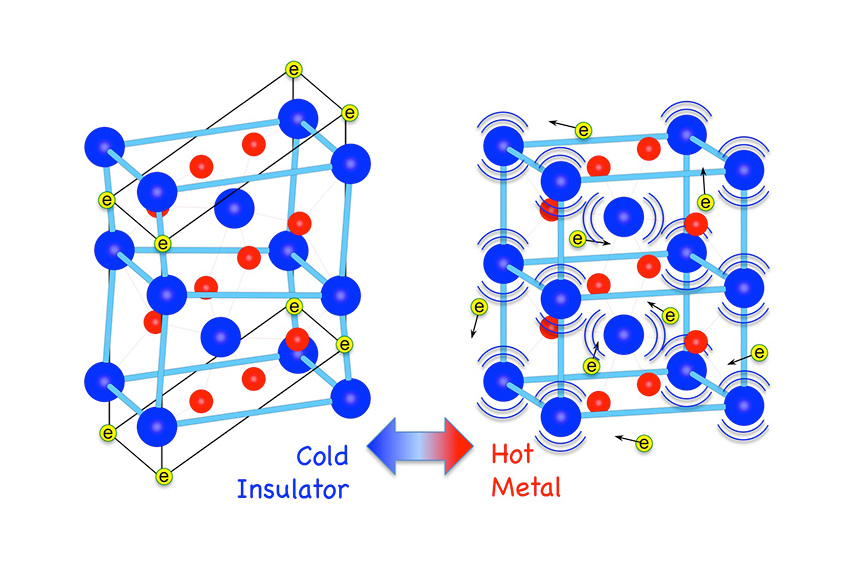Insulator-to-Metal Transition of Vanadium Dioxide
New studies explain the transition, providing a quantitative picture of a 50-year-old mystery.

The Science
When heated to just above room temperature, the electrical conductivity of vanadium dioxide (VO2) abruptly increases by a factor of 10,000. Experiments coupled with high-performance computation reveal how the unusually large lattice vibrations, which are the oscillations of atoms about their equilibrium positions, stabilize this highly conductive metallic phase.
The Impact
Achievement of a quantitative description of phase competition and functionality in metal oxides could pay great dividends in the quest to predictively design materials with unique properties.
Summary
Vanadium dioxide (VO2), a “functional material” that could be used in applications such as smart windows and ultrafast field effect transistors, exhibits an insulator to metal transition upon heating to just above room temperature. At the transition temperature, its electrical conductivity abruptly increases by a factor of 10,000 and the atomic lattice rearranges from a monoclinic to a tetragonal structure (see figure). A fundamental description of the physical and electronic properties during the transition in VO2 has remained controversial for over 50 years. Researchers at Oak Ridge National Laboratory employed advanced neutron and x-ray scattering experiments at DOE user facilities, coupled with large-scale first-principles calculations with super computers, to determine the detailed mechanism for the transition. Their studies, published in Nature, revealed that the thermodynamic force driving the insulator-to-metal transition is dominated by the lattice vibrations (phonons) rather than electronic contributions. In addition, a direct, quantitative determination of the phonon dispersions was achieved, as well as a description of how changing occupancies in the atomic orbitals participate in the phase transition. The low-energy phonons were found to change the bonds between atoms (i.e., electron orbitals), allowing some electrons to travel freely at higher temperatures leading to a metallic state. This research demonstrates that anharmonic lattice dynamics play a critical role in controlling phase competition in metal oxides, and provides the complete physical model vital for the predictive design of new materials with unique properties.
Contact
John Budai and Olivier Delaire
Oak Ridge National Laboratory
budaijd@ornl.gov; delaireoa@ornl.gov
Funding
U.S. Department of Energy, Office of Science, Basic Energy Sciences, Materials Science and Engineering Division sponsored the research. One author, Li, received Oak Ridge National Laboratory Laboratory Directed Research and Development funds. The research used Office of Science user facilities: the Advanced Photon Source, the Spallation Neutron Source, and the National Energy Research Scientific Computing Center.
Publications
J.D. Budai, J. Hong, M.E. Manley, E.D. Specht, C.W. Li, J.Z. Tischler, D.L. Abernathy, A.H. Said, B.M. Leu, L.A. Boatner, R.J. McQueeney, O. Delaire, “Metallization of vanadium dioxide driven by large phonon entropy,” Nature 515, 535-539, 2014. [DOI: 10.1038/nature13865]
Related Links
http://www.nature.com/nature/journal/vaop/ncurrent/full/nature13865.html
http://phys.org/news/2014-11-good-vibrations-electrons-insulator-metallic.html
Highlight Categories
Performer: DOE Laboratory , SC User Facilities , ASCR User Facilities , NERSC , BES User Facilities , APS , SNS



